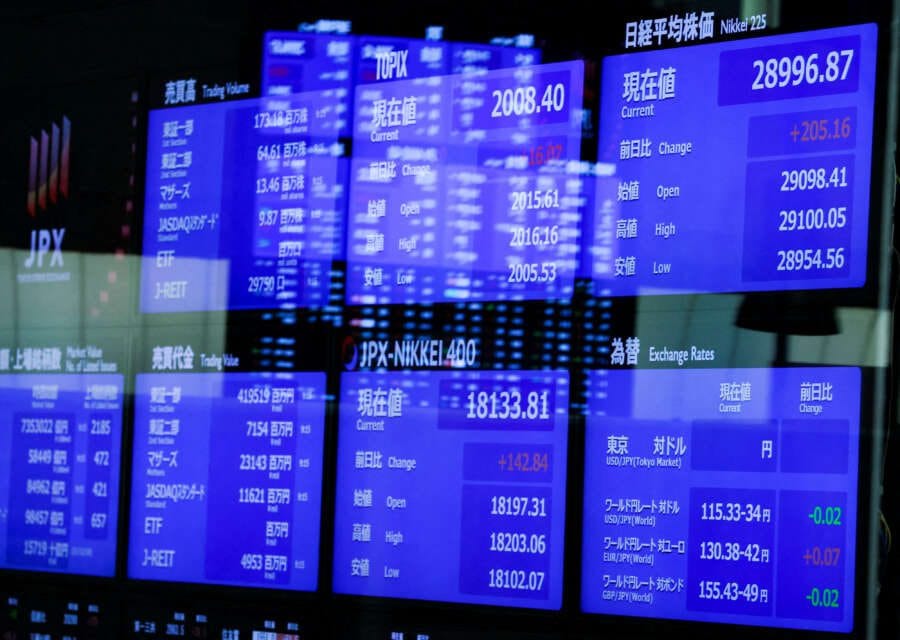
By Wayne Cole
SYDNEY (Reuters) – U.S. stock futures rallied in tense Asian trade on Monday as authorities announced plans to limit the fallout from the collapse of Silicon Valley Bank (SVB), while investors wagered a rate hike this month was no longer a certainty.
The dollar slid as Goldman Sachs predicted the U.S. Federal Reserve would no longer lift interest rates next week, capping the biggest rally for short-dated Treasuries since 1987.
The wild sea change in markets came after the Fed and U.S. Treasury announced a range of measures to stabilise the banking system and said depositors at SVB would have access to their deposits on Monday.
The Fed said it would make additional funding available through a new Bank Term Funding Program, which would offer loans up to one year to depository institutions, backed by Treasuries and other assets these institutions hold.
The moves came as authorities took possession of New York-based Signature Bank, the second bank failure in a matter of days.
Analysts noted that, importantly, the Fed would accept collateral at par rather than marking to market, allowing banks to borrow funds without having to sell assets at a loss.
“These are strong moves,” said Paul Ashworth, head of North American economics at Capital Economics.
“Rationally, this should be enough to stop any contagion from spreading and taking down more banks, which can happen in the blink of an eye in the digital age,” he added. “But contagion has always been more about irrational fear, so we would stress that there is no guarantee this will work.”
Investors reacted by sending U.S. S&P 500 stock futures up 1.6%, while Nasdaq futures rose 1.7%. EUROSTOXX 50 futures firmed 0.3%, and FTSE futures 0.1%.
MSCI’s broadest index of Asia-Pacific shares outside Japan climbed 1.4%, helped by gains in China.
Chinese blue chips added 0.8% after Beijingsurprised by keeping the head of the central bank and finance minister in their posts on Sunday, prioritising continuity as economic challenges loom at home and abroad.
Japan’s Nikkei fell 1.6% as bank stocks took a beating, while South Korea rose 0.2%.
A NEW HEADACHE FOR THE FED
Such was the concern about financial stability, that investors speculated the Fed would now be reluctant to rock the boat by lifting interest rates by a super-sized 50 basis points next week – and might not even hike at all.
Fed fund futures surged to price out any chance of a half-point hike, compared with around 70% before the SVB news broke last week. Instead, futures implied around a 14% chance the Fed would stand pat.
The implied peak for rates came all the way down to 5.08%, from 5.69% last Wednesday, and markets were back to pricing in rate cuts by the end of the year.
“In light of the stress in the banking system, we no longer expect the FOMC to deliver a rate hike at its next meeting on March 22,” wrote analysts at Goldman Sachs.
“We have left unchanged our expectation that the FOMC will deliver 25bp hikes in May, June, and July and now expect a 5.25-5.5% terminal rate, though we see considerable uncertainty about the path.”
Such talk, combined with the shift to safety, saw yields on two-year Treasuries tumble a further 17 basis points to 4.42%, a world away from last week’s 5.08% peak.
Yields were now down 66 basis points in just three sessions, a drop not seen since the Black Monday market crash in 1987.
Longer-dated yields, however, climbed and the curve steepened as inflation remained a clear concern.
Much will depend on what U.S. consumer price figures reveal on Tuesday, with an obvious risk that a high reading will pile pressure on the Fed to hike aggressively even with the financial system under strain.
The European Central Bank meets on Thursday and is still widely expected to lift its rates by 50 basis points and to flag more tightening ahead, though it will now have to take financial stability into account.
In currency markets, the dollar fell 0.9% on the safe-haven Japanese yen to 133.78, and 0.6% on the Swiss franc. The euro firmed 0.8% to $1.0735 as short-term U.S. yields plunged.
Gold climbed almost 1% to $1,885 an ounce, having jumped 2% on Friday. [GOL/]
Oil prices swung from down to up, with Brent adding 20 cents to $82.98 a barrel, while U.S. crude gained 26 cents to $76.94 per barrel.
(Reporting by Wayne Cole; Editing by Sam Holmes and Jacqueline Wong)


